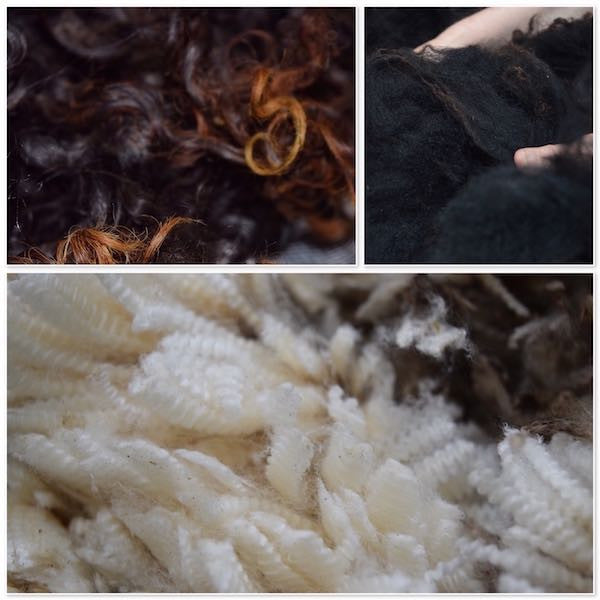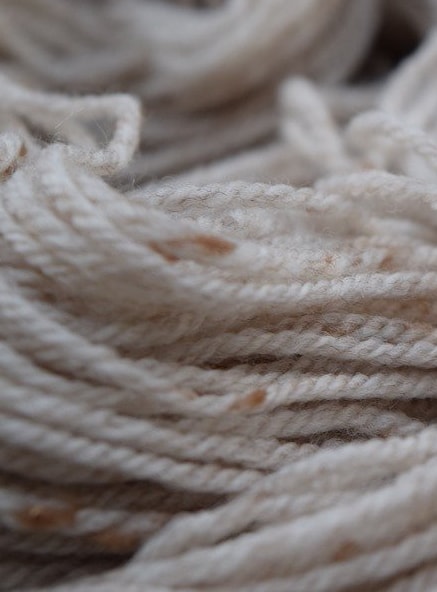Your Cart is Empty
Fast & Free shipping on all US orders.
Shop

For the Love of Wool
February 12, 2016 5 min read

It’s common for new guests at the mill to feel overwhelmed by the obscurity of knowledge that goes into making yarn. Most people know as much about wool as I do about astrophysics. As far as sheep go, Merino is a familiar word, but often mistaken as a catch-all term for all kinds of wool. People are often surprised to find out that “sheep fur” is only one of many fibers known as wool. Wool producing animals (including common terms for their fiber) which are most familiar to our mill include sheep (wool), alpaca (alpaca), goat (cashmere & mohair), and rabbit (angora). Llama (llama), camel (camel), and musk ox (qiviut) also produce wool, but we rarely see them at the mill.
Wool is defined as natural fiber with elasticity, crimp, and staple structure.
Elasticity is the fibers’ ability to be stretched, strained, soaked, and twisted, but still return to its original form, which it does better than any other plant or animal fiber. Crimp describes how tightly or loosely the protein strands are coiled making the fiber appear as ringlets or zig zags. Staples are clusters of strands that grow together in groups forming a tip on the outer end. The combined qualities of wool are what make it exceptionally durable, comfortable, dyeable, flame retardant, water resistant, lint and stain resistant, and even regulate temperature - keeping warm (even when wet) in the winter and cool in the summer. In addition to all of this, wool is a recyclable, biodegradable, and renewable natural resource which has been adored by humans for over 10,000 years.
Variations on the three basic attributes of wool give us an unlimited palette of textures and potential uses for wool ranging from industrial to personal. There are countless breeds of wool producing animals in the world, and countless variations of fiber characteristics within each breed. Even within the lifetime of one single animal, the quality and characteristics (including color) of its fiber can vary from year to year depending on elements beyond his or her control such as weather, climate change, illness, stress, diet, and age. In general, breed associations strive to identify the most useful characteristics and promote breeding for uniformity of those qualities (at least I hope they do - uniformity is the absolute key to quality).
Washington and Oregon are great wool producing states for the variety of climate regions spanning east to west. In addition to having a great climate for raising alpaca , we are home to a wide range of thriving sheep breeds. Some (by no means all) of the sheep breeds in the Northwest which I have come to know and love include fine wools such as Targhee, CVM, Rambouillet, and Targhee. Local medium and downy breeds I often see are Corriedale, Oxford, Dorset, Columbia, and East Fresian. I absolutely love any opportunity I get to work with Shetlands, Icelandic, Cheviot, Jacob or other primitive breeds. But perhaps my all-time favorite local breeds are the longwools. I’m not yet sure why, but I go gaga every time I start a new batch of longwool yarn. Romney, Cotswold, Gotland, Lincoln, English Leicester, Wensleydale, Teesewater, Coopworth, and Border Leicester are some of the longwool breeds you might find me drooling over.
Each of these breeds has their own story and characteristics which I recognize and expect when their fiber comes through my door. Every diverse fleece can be appreciated for what it is, and designed for best use. I especially love seeing natural colored fleeces (any color besides white) in any breed. Don’t get me wrong, I love white as well. Natural colored fleeces are adored though, because there are so few in comparison to white, which are in higher demand for commercial use. That is not to imply commercial processing is bad. I appreciate and deeply admire the large mills in our country who have survived very hard times in order to remain domestic producers. They play an important role, and we need them. Their products, however, are different from mine because their process is different. Not bad, just different.
When large quantities of wool are baled and sold at auction for large production mills, the quality of the fiber is evaluated in a laboratory by taking a core sample and running it through a series of tests that give a summary of its quality, cleanliness, and fineness. At my mill, I buy direct from farmers and evaluate each fleece by hand. I take great pride in this. I think of the work I do as “reading” each fleece in order to decide how to make best use of its characteristics. It keeps me connected with the people and animals who I rely on to make yarn. I also feel it adds a “living” quality to my yarn because it allows me to acknowledge and preserve the authentic attributes in each batch and even spotlight exceptional ones. There technical aspects this work of course, but when its just me and a bag of fiber, I'm all zen. My creative centers light up and my mind races around all the ways to spin, blend or card the fiber in front of me. I feel a thrill of excitement every single time I look into a bag or bale of fiber. I love it all. This is my art.
Unfortunately, as many independent artists are painfully aware, the road ahead is not exactly paved. The current state of local, small batch wool production and processing in our country is tenuous. I have observed farmers, mills, and independent artisans all looking at each other and wondering where the profits are hiding. From my perspective, it seems the global textile supply chain is in such poor health that the burden reaches to all of us. I don't believe any one member of the supply chain can afford to not care about the greater whole. If our local, small farms are not sustainable, my supply will disappear. We simply cannot think of ourselves as isolated entities. The truth is, we need each other.
When change affects the environment in drastic ways, survival has always depended on adaptation. The obvious way forward is to innovate. This gives me hope. The opportunity to think outside the box and make something of tomorrow that did not exist yesterday is exactly what I live for. We don't need to reinvent the wheel. I think the future will have deep roots in our treasured past. It is simply time to look at the things we value most and start building a new home for them in the future. To do this, we need to revive our ability to rely on each other, and work hard together for a common goal. Yarn is made when a great many individual strands of fiber draft and twist as one, making them stronger as a whole than any one of them is by itself. Maybe diversity matters. Process matters. People matter. Our natural resources matter. Perhaps bigger is not always better. I never stop thinking about what the future for local wool might look like, and I’m sure I’m not the only one. If any of this resonates with you, or if you have asked yourself the same questions, then we are in this together. Tell us, what does the future look like to you?
Leave a comment
Comments will be approved before showing up.

Join Our Newsletter
Our weekly newsletter is plain and simple.
Just one or two headlines from our Mill Shop, so you can be the first to grab limited editions and special offers.

